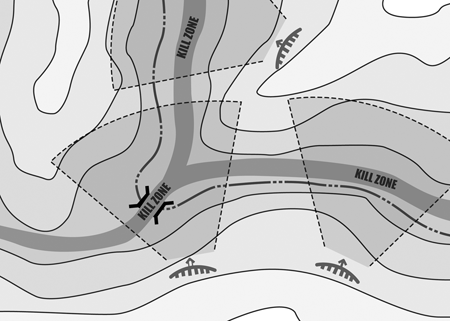Ambushes are classified by category (deliberate or hasty), formation (linear or L-shaped), and type (point, area, or antiarmor). The leader determines the category of ambush through an analysis of the factors of METT-TC. Typically, the two most important factors are time and enemy. The leader’s key planning considerations for any ambush include the following:
• Cover the entire kill zone (engagement area) by fire
• Use existing terrain features (rocks or fallen trees, for example) or reinforcing obstacles (Claymores or other mines) orienting into the kill zone to keep the enemy in the kill zone
• Determine how to emplace reinforcing obstacles on the far side of the kill zone
• Protect the assault and support elements with mines, Claymores, or explosives
• Use the security element to isolate the kill zone
• Establish rear security behind the assault element
• Assault into the kill zone to search dead and wounded, to assemble prisoners, and to collect equipment. The assault element must be able to move quickly on its own through the ambush site protective obstacles.
• Time the actions of all elements of the platoon to prevent the loss of surprise
Deliberate
A deliberate ambush is a planned offensive action conducted against a specific target for a specific purpose at a predetermined location. When planning a deliberate ambush, the leader requires detailed information on the—
• Size and composition of the targeted enemy unit
• Weapons and equipment available to the enemy
• Enemy’s route and direction of movement
• Times that the targeted enemy unit will reach or pass specified points along the route
Hasty
A hasty ambush is conducted when a unit makes visual contact with an enemy force and has time to establish an ambush without being detected. The conduct of the hasty ambush should represent the execution of disciplined initiative within the parameters of the commander’s intent. The actions for a hasty ambush should be established in a unit SOP and rehearsed so Soldiers know what to do on the leader’s signal.
Area Ambush
An area ambush (more than one point ambush) is not conducted by a unit smaller than a platoon. This ambush works best where enemy movement is restricted. Once the platoon is prepared, the area ambush is conducted the same as a point ambush. The dominating feature of an area ambush is the amount of synchronization between the separate point ambushes.

Area ambushes trap the enemy in a network of attacks from multiple concealed positions. These ambushes are carefully oriented to avoid “friendly fire” and yet maximize combat power against the enemy.
Area ambushes require more planning and control to execute successfully. Surprise is more difficult to achieve due to the unit’s dispersion in the AO. Having more than one ambush site increases the likelihood of being detected by the enemy or civilians. This major disadvantage is offset by the increased flexibility and sophistication available to the leader.
Point Ambushes
Point ambushes are set at the most ideal location to inflict damage on the enemy. Such ambushes must be able to handle being hit by the enemy force from more than one direction. The ambush site should enable the unit to execute an ambush in two or three main directions. The other directions must be covered by security that gives early warning of enemy attack.
 This article is an extract from "SUTS3: The Small Unit Tactics SMARTbook, 3rd Ed. (Planning & Conducting Tactical Operations)" by The Lightning Press. Download a free PDF sample and learn more at: SUTS3: The Small Unit Tactics SMARTbook, 3rd Ed. (Planning & Conducting Tactical Operations).
This article is an extract from "SUTS3: The Small Unit Tactics SMARTbook, 3rd Ed. (Planning & Conducting Tactical Operations)" by The Lightning Press. Download a free PDF sample and learn more at: SUTS3: The Small Unit Tactics SMARTbook, 3rd Ed. (Planning & Conducting Tactical Operations).
Browse additional military doctrine articles in our SMARTnews Blog & Resource Center.
About The Lightning Press SMARTbooks. Recognized as a “whole of government” doctrinal reference standard by military, national security and government professionals around the world, SMARTbooks comprise a comprehensive professional library. SMARTbooks can be used as quick reference guides during operations, as study guides at education and professional development courses, and as lesson plans and checklists in support of training. Browse our collection of Military Reference SMARTbooks to learn more.













































